The Impact of Toxic Leadership on Employee Retention: A Study on ASDA
VerifiedAdded on 2020/12/30
|10
|3088
|385
Report
AI Summary
This report investigates the effects of toxic leadership on employee retention, focusing on the case of ASDA. The introduction defines toxic leadership and its negative impacts on organizational performance, employee motivation, and ethical considerations. The literature review explores the concept of toxic leadership, its influence on employee retention, and strategies to improve it. The research methodology section outlines qualitative and quantitative approaches, along with primary and secondary data collection methods, including questionnaires and interviews. The report also addresses ethical considerations in research. The conclusion summarizes the findings and emphasizes the importance of addressing toxic leadership to improve employee retention and overall organizational success. The report suggests ways to overcome toxic leadership by increasing employee motivation, changing organizational culture, and meeting employee needs. Finally, the report highlights the importance of a healthy work environment, including safety and security.

Foundation Project
Paraphrase This Document
Need a fresh take? Get an instant paraphrase of this document with our AI Paraphraser
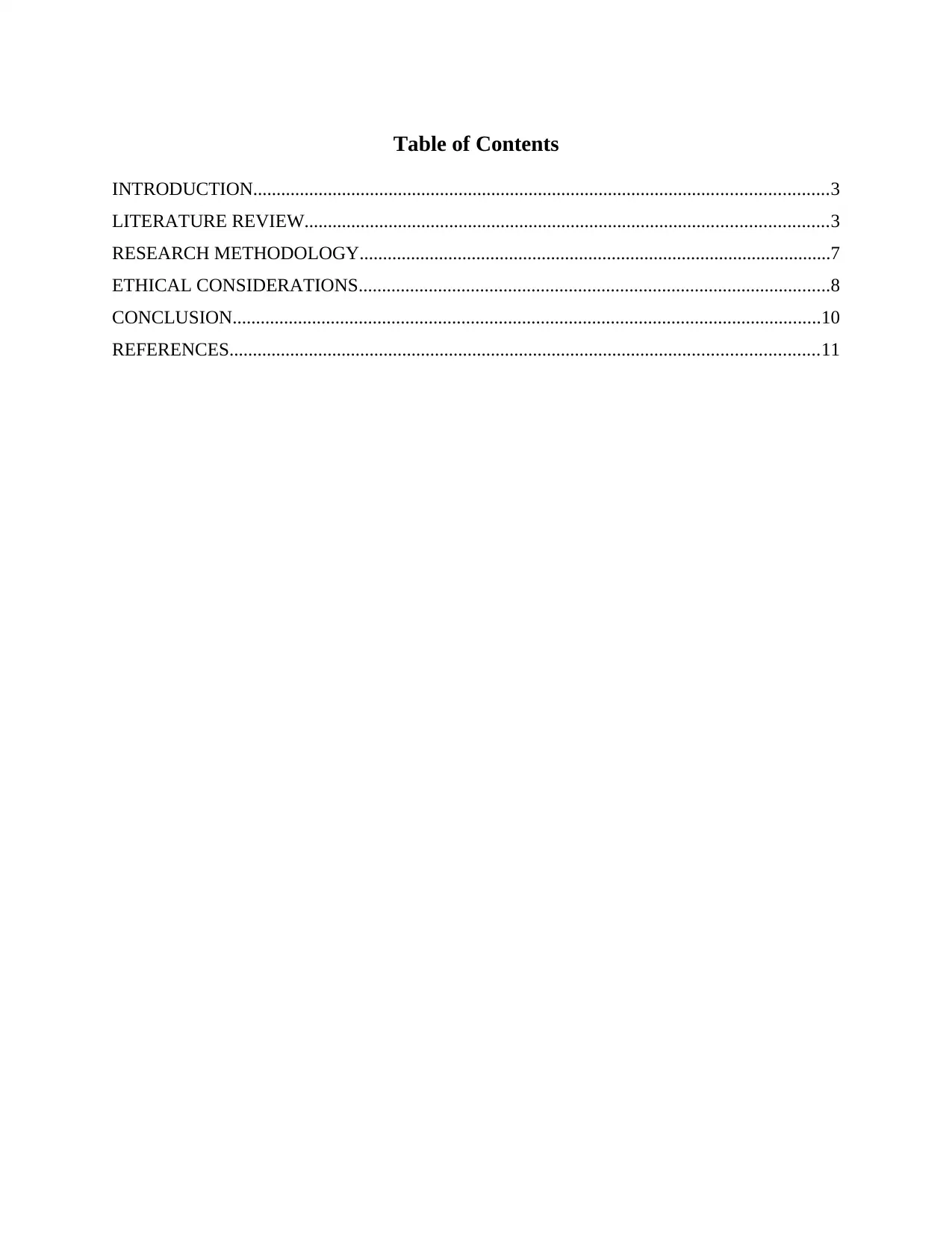
Table of Contents
INTRODUCTION...........................................................................................................................3
LITERATURE REVIEW................................................................................................................3
RESEARCH METHODOLOGY.....................................................................................................7
ETHICAL CONSIDERATIONS.....................................................................................................8
CONCLUSION..............................................................................................................................10
REFERENCES..............................................................................................................................11
INTRODUCTION...........................................................................................................................3
LITERATURE REVIEW................................................................................................................3
RESEARCH METHODOLOGY.....................................................................................................7
ETHICAL CONSIDERATIONS.....................................................................................................8
CONCLUSION..............................................................................................................................10
REFERENCES..............................................................................................................................11
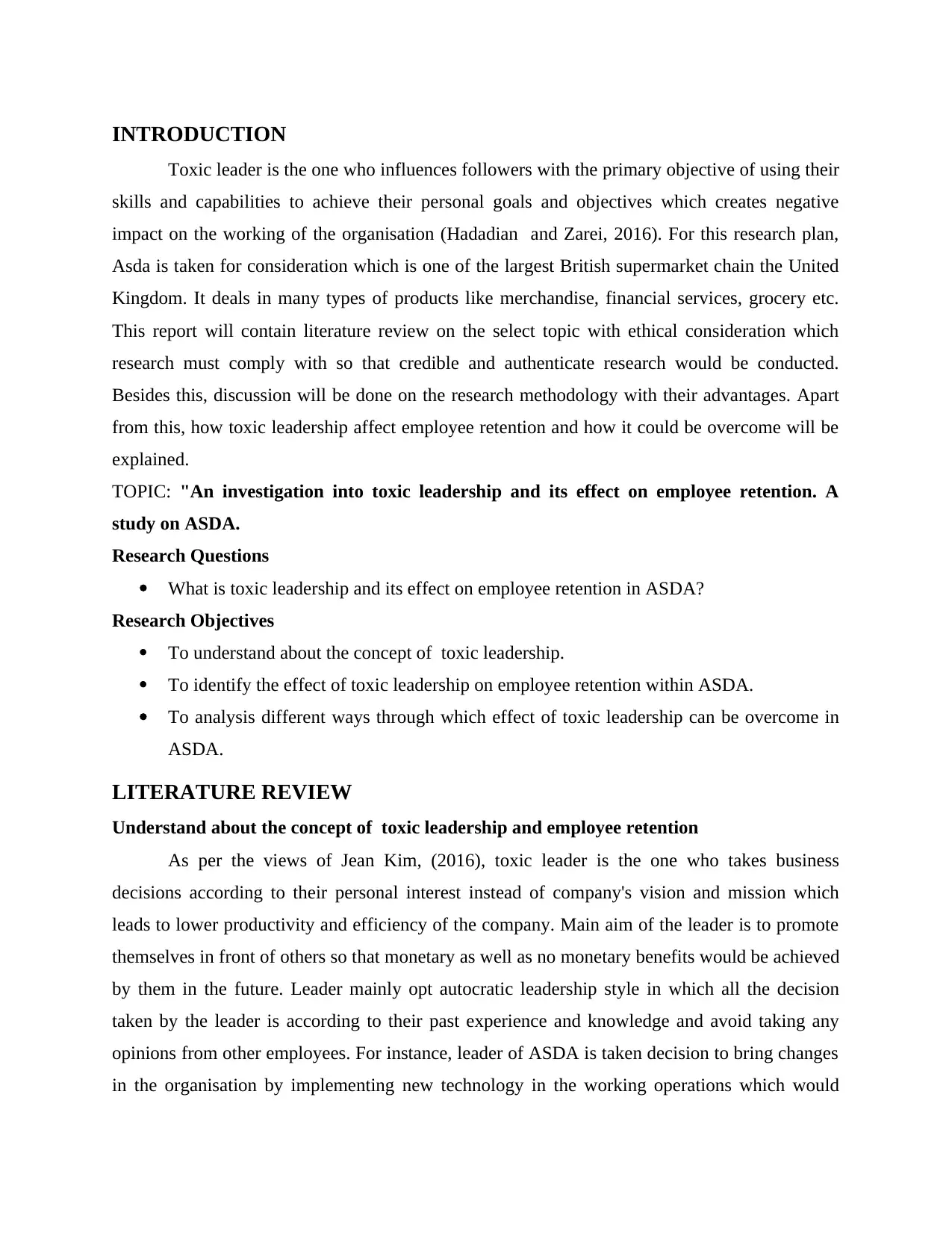
INTRODUCTION
Toxic leader is the one who influences followers with the primary objective of using their
skills and capabilities to achieve their personal goals and objectives which creates negative
impact on the working of the organisation (Hadadian and Zarei, 2016). For this research plan,
Asda is taken for consideration which is one of the largest British supermarket chain the United
Kingdom. It deals in many types of products like merchandise, financial services, grocery etc.
This report will contain literature review on the select topic with ethical consideration which
research must comply with so that credible and authenticate research would be conducted.
Besides this, discussion will be done on the research methodology with their advantages. Apart
from this, how toxic leadership affect employee retention and how it could be overcome will be
explained.
TOPIC: "An investigation into toxic leadership and its effect on employee retention. A
study on ASDA.
Research Questions
What is toxic leadership and its effect on employee retention in ASDA?
Research Objectives
To understand about the concept of toxic leadership.
To identify the effect of toxic leadership on employee retention within ASDA.
To analysis different ways through which effect of toxic leadership can be overcome in
ASDA.
LITERATURE REVIEW
Understand about the concept of toxic leadership and employee retention
As per the views of Jean Kim, (2016), toxic leader is the one who takes business
decisions according to their personal interest instead of company's vision and mission which
leads to lower productivity and efficiency of the company. Main aim of the leader is to promote
themselves in front of others so that monetary as well as no monetary benefits would be achieved
by them in the future. Leader mainly opt autocratic leadership style in which all the decision
taken by the leader is according to their past experience and knowledge and avoid taking any
opinions from other employees. For instance, leader of ASDA is taken decision to bring changes
in the organisation by implementing new technology in the working operations which would
Toxic leader is the one who influences followers with the primary objective of using their
skills and capabilities to achieve their personal goals and objectives which creates negative
impact on the working of the organisation (Hadadian and Zarei, 2016). For this research plan,
Asda is taken for consideration which is one of the largest British supermarket chain the United
Kingdom. It deals in many types of products like merchandise, financial services, grocery etc.
This report will contain literature review on the select topic with ethical consideration which
research must comply with so that credible and authenticate research would be conducted.
Besides this, discussion will be done on the research methodology with their advantages. Apart
from this, how toxic leadership affect employee retention and how it could be overcome will be
explained.
TOPIC: "An investigation into toxic leadership and its effect on employee retention. A
study on ASDA.
Research Questions
What is toxic leadership and its effect on employee retention in ASDA?
Research Objectives
To understand about the concept of toxic leadership.
To identify the effect of toxic leadership on employee retention within ASDA.
To analysis different ways through which effect of toxic leadership can be overcome in
ASDA.
LITERATURE REVIEW
Understand about the concept of toxic leadership and employee retention
As per the views of Jean Kim, (2016), toxic leader is the one who takes business
decisions according to their personal interest instead of company's vision and mission which
leads to lower productivity and efficiency of the company. Main aim of the leader is to promote
themselves in front of others so that monetary as well as no monetary benefits would be achieved
by them in the future. Leader mainly opt autocratic leadership style in which all the decision
taken by the leader is according to their past experience and knowledge and avoid taking any
opinions from other employees. For instance, leader of ASDA is taken decision to bring changes
in the organisation by implementing new technology in the working operations which would
⊘ This is a preview!⊘
Do you want full access?
Subscribe today to unlock all pages.

Trusted by 1+ million students worldwide
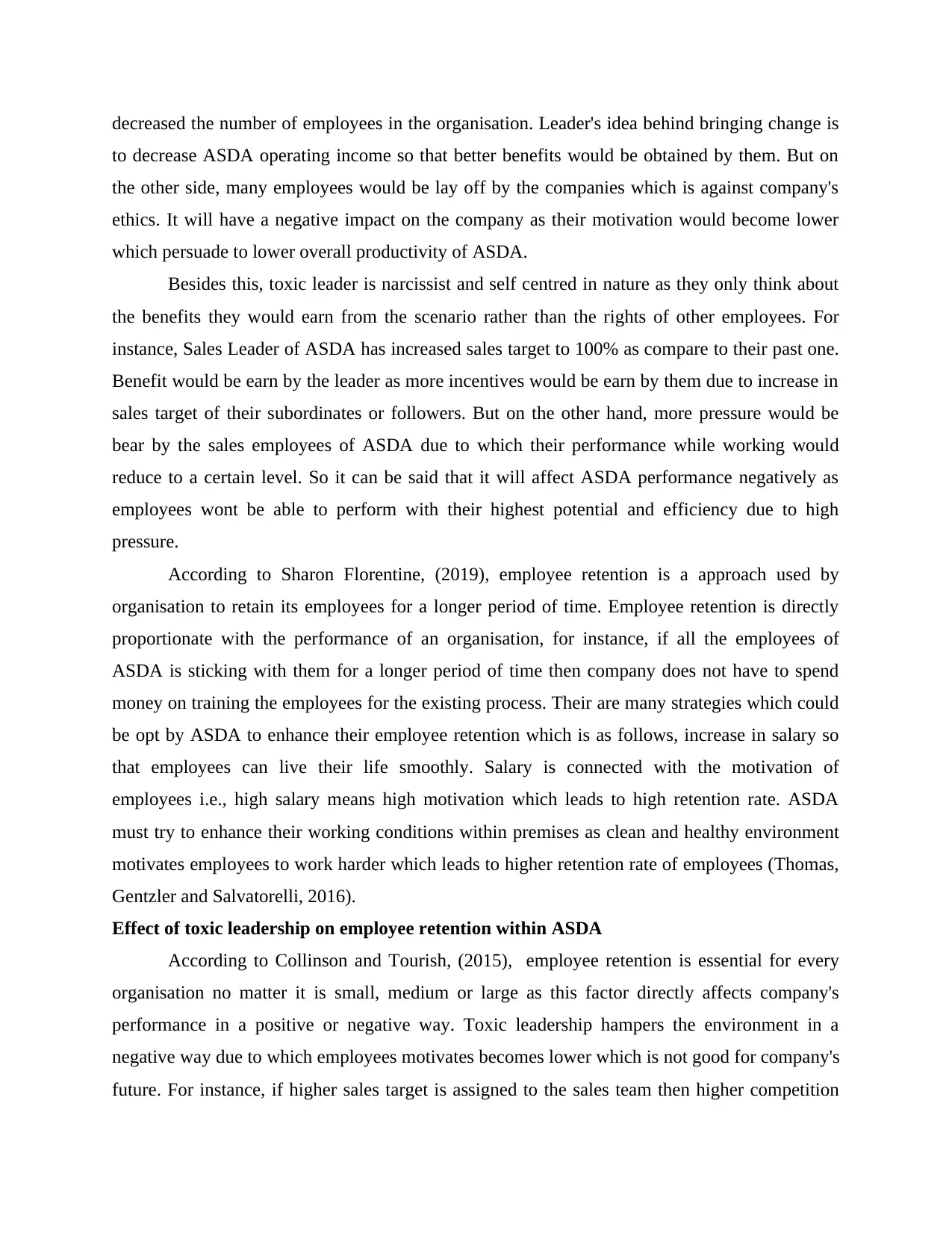
decreased the number of employees in the organisation. Leader's idea behind bringing change is
to decrease ASDA operating income so that better benefits would be obtained by them. But on
the other side, many employees would be lay off by the companies which is against company's
ethics. It will have a negative impact on the company as their motivation would become lower
which persuade to lower overall productivity of ASDA.
Besides this, toxic leader is narcissist and self centred in nature as they only think about
the benefits they would earn from the scenario rather than the rights of other employees. For
instance, Sales Leader of ASDA has increased sales target to 100% as compare to their past one.
Benefit would be earn by the leader as more incentives would be earn by them due to increase in
sales target of their subordinates or followers. But on the other hand, more pressure would be
bear by the sales employees of ASDA due to which their performance while working would
reduce to a certain level. So it can be said that it will affect ASDA performance negatively as
employees wont be able to perform with their highest potential and efficiency due to high
pressure.
According to Sharon Florentine, (2019), employee retention is a approach used by
organisation to retain its employees for a longer period of time. Employee retention is directly
proportionate with the performance of an organisation, for instance, if all the employees of
ASDA is sticking with them for a longer period of time then company does not have to spend
money on training the employees for the existing process. Their are many strategies which could
be opt by ASDA to enhance their employee retention which is as follows, increase in salary so
that employees can live their life smoothly. Salary is connected with the motivation of
employees i.e., high salary means high motivation which leads to high retention rate. ASDA
must try to enhance their working conditions within premises as clean and healthy environment
motivates employees to work harder which leads to higher retention rate of employees (Thomas,
Gentzler and Salvatorelli, 2016).
Effect of toxic leadership on employee retention within ASDA
According to Collinson and Tourish, (2015), employee retention is essential for every
organisation no matter it is small, medium or large as this factor directly affects company's
performance in a positive or negative way. Toxic leadership hampers the environment in a
negative way due to which employees motivates becomes lower which is not good for company's
future. For instance, if higher sales target is assigned to the sales team then higher competition
to decrease ASDA operating income so that better benefits would be obtained by them. But on
the other side, many employees would be lay off by the companies which is against company's
ethics. It will have a negative impact on the company as their motivation would become lower
which persuade to lower overall productivity of ASDA.
Besides this, toxic leader is narcissist and self centred in nature as they only think about
the benefits they would earn from the scenario rather than the rights of other employees. For
instance, Sales Leader of ASDA has increased sales target to 100% as compare to their past one.
Benefit would be earn by the leader as more incentives would be earn by them due to increase in
sales target of their subordinates or followers. But on the other hand, more pressure would be
bear by the sales employees of ASDA due to which their performance while working would
reduce to a certain level. So it can be said that it will affect ASDA performance negatively as
employees wont be able to perform with their highest potential and efficiency due to high
pressure.
According to Sharon Florentine, (2019), employee retention is a approach used by
organisation to retain its employees for a longer period of time. Employee retention is directly
proportionate with the performance of an organisation, for instance, if all the employees of
ASDA is sticking with them for a longer period of time then company does not have to spend
money on training the employees for the existing process. Their are many strategies which could
be opt by ASDA to enhance their employee retention which is as follows, increase in salary so
that employees can live their life smoothly. Salary is connected with the motivation of
employees i.e., high salary means high motivation which leads to high retention rate. ASDA
must try to enhance their working conditions within premises as clean and healthy environment
motivates employees to work harder which leads to higher retention rate of employees (Thomas,
Gentzler and Salvatorelli, 2016).
Effect of toxic leadership on employee retention within ASDA
According to Collinson and Tourish, (2015), employee retention is essential for every
organisation no matter it is small, medium or large as this factor directly affects company's
performance in a positive or negative way. Toxic leadership hampers the environment in a
negative way due to which employees motivates becomes lower which is not good for company's
future. For instance, if higher sales target is assigned to the sales team then higher competition
Paraphrase This Document
Need a fresh take? Get an instant paraphrase of this document with our AI Paraphraser
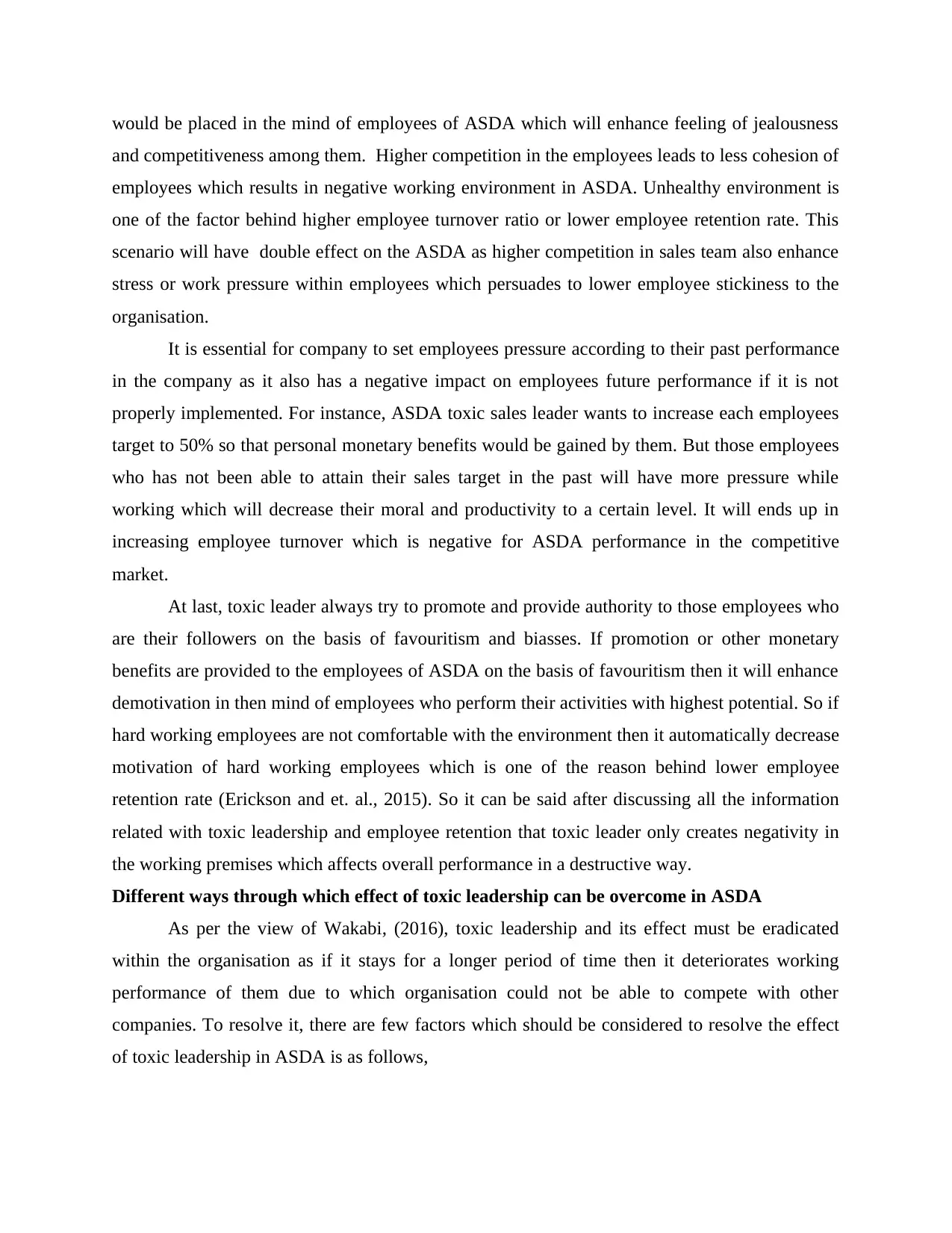
would be placed in the mind of employees of ASDA which will enhance feeling of jealousness
and competitiveness among them. Higher competition in the employees leads to less cohesion of
employees which results in negative working environment in ASDA. Unhealthy environment is
one of the factor behind higher employee turnover ratio or lower employee retention rate. This
scenario will have double effect on the ASDA as higher competition in sales team also enhance
stress or work pressure within employees which persuades to lower employee stickiness to the
organisation.
It is essential for company to set employees pressure according to their past performance
in the company as it also has a negative impact on employees future performance if it is not
properly implemented. For instance, ASDA toxic sales leader wants to increase each employees
target to 50% so that personal monetary benefits would be gained by them. But those employees
who has not been able to attain their sales target in the past will have more pressure while
working which will decrease their moral and productivity to a certain level. It will ends up in
increasing employee turnover which is negative for ASDA performance in the competitive
market.
At last, toxic leader always try to promote and provide authority to those employees who
are their followers on the basis of favouritism and biasses. If promotion or other monetary
benefits are provided to the employees of ASDA on the basis of favouritism then it will enhance
demotivation in then mind of employees who perform their activities with highest potential. So if
hard working employees are not comfortable with the environment then it automatically decrease
motivation of hard working employees which is one of the reason behind lower employee
retention rate (Erickson and et. al., 2015). So it can be said after discussing all the information
related with toxic leadership and employee retention that toxic leader only creates negativity in
the working premises which affects overall performance in a destructive way.
Different ways through which effect of toxic leadership can be overcome in ASDA
As per the view of Wakabi, (2016), toxic leadership and its effect must be eradicated
within the organisation as if it stays for a longer period of time then it deteriorates working
performance of them due to which organisation could not be able to compete with other
companies. To resolve it, there are few factors which should be considered to resolve the effect
of toxic leadership in ASDA is as follows,
and competitiveness among them. Higher competition in the employees leads to less cohesion of
employees which results in negative working environment in ASDA. Unhealthy environment is
one of the factor behind higher employee turnover ratio or lower employee retention rate. This
scenario will have double effect on the ASDA as higher competition in sales team also enhance
stress or work pressure within employees which persuades to lower employee stickiness to the
organisation.
It is essential for company to set employees pressure according to their past performance
in the company as it also has a negative impact on employees future performance if it is not
properly implemented. For instance, ASDA toxic sales leader wants to increase each employees
target to 50% so that personal monetary benefits would be gained by them. But those employees
who has not been able to attain their sales target in the past will have more pressure while
working which will decrease their moral and productivity to a certain level. It will ends up in
increasing employee turnover which is negative for ASDA performance in the competitive
market.
At last, toxic leader always try to promote and provide authority to those employees who
are their followers on the basis of favouritism and biasses. If promotion or other monetary
benefits are provided to the employees of ASDA on the basis of favouritism then it will enhance
demotivation in then mind of employees who perform their activities with highest potential. So if
hard working employees are not comfortable with the environment then it automatically decrease
motivation of hard working employees which is one of the reason behind lower employee
retention rate (Erickson and et. al., 2015). So it can be said after discussing all the information
related with toxic leadership and employee retention that toxic leader only creates negativity in
the working premises which affects overall performance in a destructive way.
Different ways through which effect of toxic leadership can be overcome in ASDA
As per the view of Wakabi, (2016), toxic leadership and its effect must be eradicated
within the organisation as if it stays for a longer period of time then it deteriorates working
performance of them due to which organisation could not be able to compete with other
companies. To resolve it, there are few factors which should be considered to resolve the effect
of toxic leadership in ASDA is as follows,
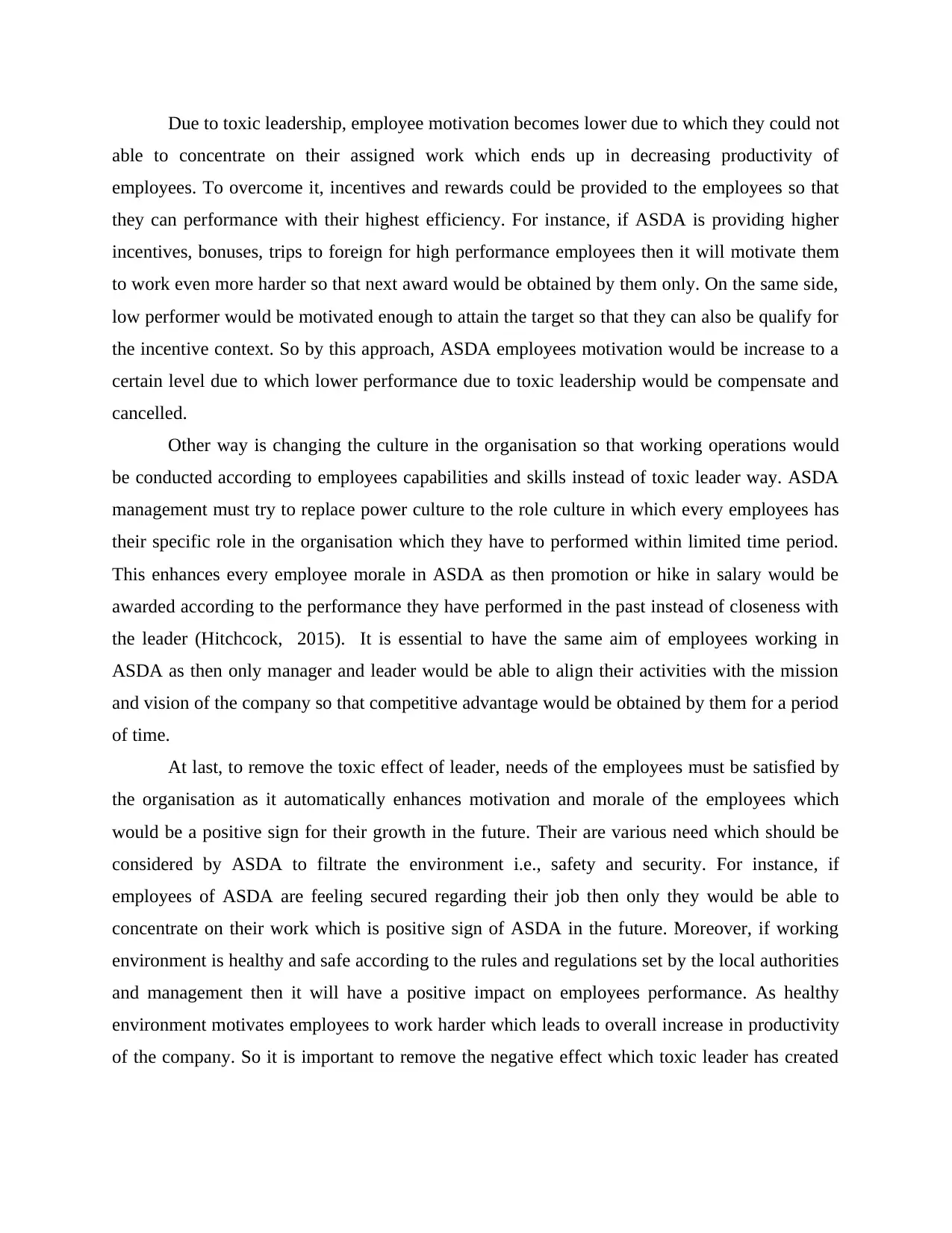
Due to toxic leadership, employee motivation becomes lower due to which they could not
able to concentrate on their assigned work which ends up in decreasing productivity of
employees. To overcome it, incentives and rewards could be provided to the employees so that
they can performance with their highest efficiency. For instance, if ASDA is providing higher
incentives, bonuses, trips to foreign for high performance employees then it will motivate them
to work even more harder so that next award would be obtained by them only. On the same side,
low performer would be motivated enough to attain the target so that they can also be qualify for
the incentive context. So by this approach, ASDA employees motivation would be increase to a
certain level due to which lower performance due to toxic leadership would be compensate and
cancelled.
Other way is changing the culture in the organisation so that working operations would
be conducted according to employees capabilities and skills instead of toxic leader way. ASDA
management must try to replace power culture to the role culture in which every employees has
their specific role in the organisation which they have to performed within limited time period.
This enhances every employee morale in ASDA as then promotion or hike in salary would be
awarded according to the performance they have performed in the past instead of closeness with
the leader (Hitchcock, 2015). It is essential to have the same aim of employees working in
ASDA as then only manager and leader would be able to align their activities with the mission
and vision of the company so that competitive advantage would be obtained by them for a period
of time.
At last, to remove the toxic effect of leader, needs of the employees must be satisfied by
the organisation as it automatically enhances motivation and morale of the employees which
would be a positive sign for their growth in the future. Their are various need which should be
considered by ASDA to filtrate the environment i.e., safety and security. For instance, if
employees of ASDA are feeling secured regarding their job then only they would be able to
concentrate on their work which is positive sign of ASDA in the future. Moreover, if working
environment is healthy and safe according to the rules and regulations set by the local authorities
and management then it will have a positive impact on employees performance. As healthy
environment motivates employees to work harder which leads to overall increase in productivity
of the company. So it is important to remove the negative effect which toxic leader has created
able to concentrate on their assigned work which ends up in decreasing productivity of
employees. To overcome it, incentives and rewards could be provided to the employees so that
they can performance with their highest efficiency. For instance, if ASDA is providing higher
incentives, bonuses, trips to foreign for high performance employees then it will motivate them
to work even more harder so that next award would be obtained by them only. On the same side,
low performer would be motivated enough to attain the target so that they can also be qualify for
the incentive context. So by this approach, ASDA employees motivation would be increase to a
certain level due to which lower performance due to toxic leadership would be compensate and
cancelled.
Other way is changing the culture in the organisation so that working operations would
be conducted according to employees capabilities and skills instead of toxic leader way. ASDA
management must try to replace power culture to the role culture in which every employees has
their specific role in the organisation which they have to performed within limited time period.
This enhances every employee morale in ASDA as then promotion or hike in salary would be
awarded according to the performance they have performed in the past instead of closeness with
the leader (Hitchcock, 2015). It is essential to have the same aim of employees working in
ASDA as then only manager and leader would be able to align their activities with the mission
and vision of the company so that competitive advantage would be obtained by them for a period
of time.
At last, to remove the toxic effect of leader, needs of the employees must be satisfied by
the organisation as it automatically enhances motivation and morale of the employees which
would be a positive sign for their growth in the future. Their are various need which should be
considered by ASDA to filtrate the environment i.e., safety and security. For instance, if
employees of ASDA are feeling secured regarding their job then only they would be able to
concentrate on their work which is positive sign of ASDA in the future. Moreover, if working
environment is healthy and safe according to the rules and regulations set by the local authorities
and management then it will have a positive impact on employees performance. As healthy
environment motivates employees to work harder which leads to overall increase in productivity
of the company. So it is important to remove the negative effect which toxic leader has created
⊘ This is a preview!⊘
Do you want full access?
Subscribe today to unlock all pages.

Trusted by 1+ million students worldwide
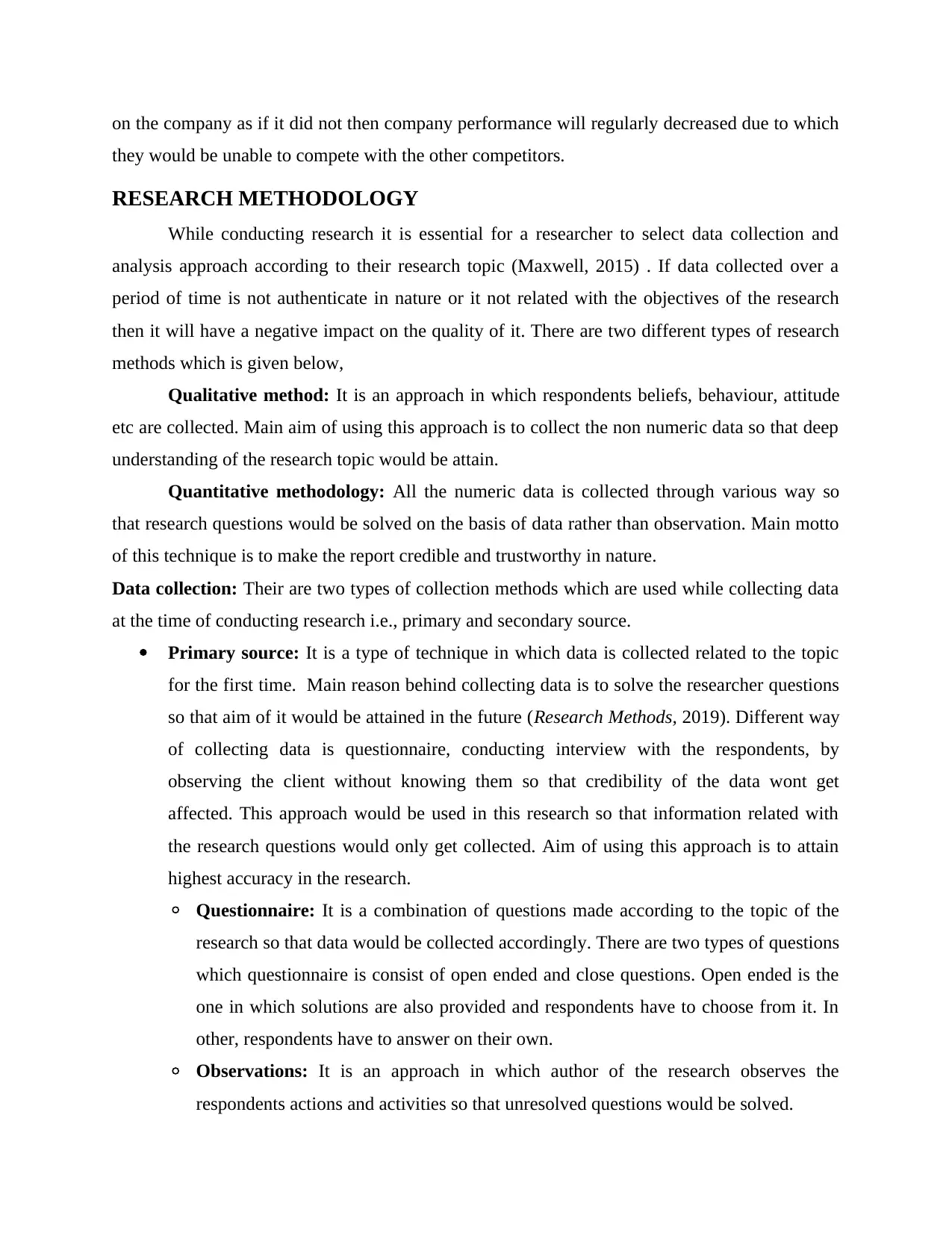
on the company as if it did not then company performance will regularly decreased due to which
they would be unable to compete with the other competitors.
RESEARCH METHODOLOGY
While conducting research it is essential for a researcher to select data collection and
analysis approach according to their research topic (Maxwell, 2015) . If data collected over a
period of time is not authenticate in nature or it not related with the objectives of the research
then it will have a negative impact on the quality of it. There are two different types of research
methods which is given below,
Qualitative method: It is an approach in which respondents beliefs, behaviour, attitude
etc are collected. Main aim of using this approach is to collect the non numeric data so that deep
understanding of the research topic would be attain.
Quantitative methodology: All the numeric data is collected through various way so
that research questions would be solved on the basis of data rather than observation. Main motto
of this technique is to make the report credible and trustworthy in nature.
Data collection: Their are two types of collection methods which are used while collecting data
at the time of conducting research i.e., primary and secondary source.
Primary source: It is a type of technique in which data is collected related to the topic
for the first time. Main reason behind collecting data is to solve the researcher questions
so that aim of it would be attained in the future (Research Methods, 2019). Different way
of collecting data is questionnaire, conducting interview with the respondents, by
observing the client without knowing them so that credibility of the data wont get
affected. This approach would be used in this research so that information related with
the research questions would only get collected. Aim of using this approach is to attain
highest accuracy in the research.
◦ Questionnaire: It is a combination of questions made according to the topic of the
research so that data would be collected accordingly. There are two types of questions
which questionnaire is consist of open ended and close questions. Open ended is the
one in which solutions are also provided and respondents have to choose from it. In
other, respondents have to answer on their own.
◦ Observations: It is an approach in which author of the research observes the
respondents actions and activities so that unresolved questions would be solved.
they would be unable to compete with the other competitors.
RESEARCH METHODOLOGY
While conducting research it is essential for a researcher to select data collection and
analysis approach according to their research topic (Maxwell, 2015) . If data collected over a
period of time is not authenticate in nature or it not related with the objectives of the research
then it will have a negative impact on the quality of it. There are two different types of research
methods which is given below,
Qualitative method: It is an approach in which respondents beliefs, behaviour, attitude
etc are collected. Main aim of using this approach is to collect the non numeric data so that deep
understanding of the research topic would be attain.
Quantitative methodology: All the numeric data is collected through various way so
that research questions would be solved on the basis of data rather than observation. Main motto
of this technique is to make the report credible and trustworthy in nature.
Data collection: Their are two types of collection methods which are used while collecting data
at the time of conducting research i.e., primary and secondary source.
Primary source: It is a type of technique in which data is collected related to the topic
for the first time. Main reason behind collecting data is to solve the researcher questions
so that aim of it would be attained in the future (Research Methods, 2019). Different way
of collecting data is questionnaire, conducting interview with the respondents, by
observing the client without knowing them so that credibility of the data wont get
affected. This approach would be used in this research so that information related with
the research questions would only get collected. Aim of using this approach is to attain
highest accuracy in the research.
◦ Questionnaire: It is a combination of questions made according to the topic of the
research so that data would be collected accordingly. There are two types of questions
which questionnaire is consist of open ended and close questions. Open ended is the
one in which solutions are also provided and respondents have to choose from it. In
other, respondents have to answer on their own.
◦ Observations: It is an approach in which author of the research observes the
respondents actions and activities so that unresolved questions would be solved.
Paraphrase This Document
Need a fresh take? Get an instant paraphrase of this document with our AI Paraphraser
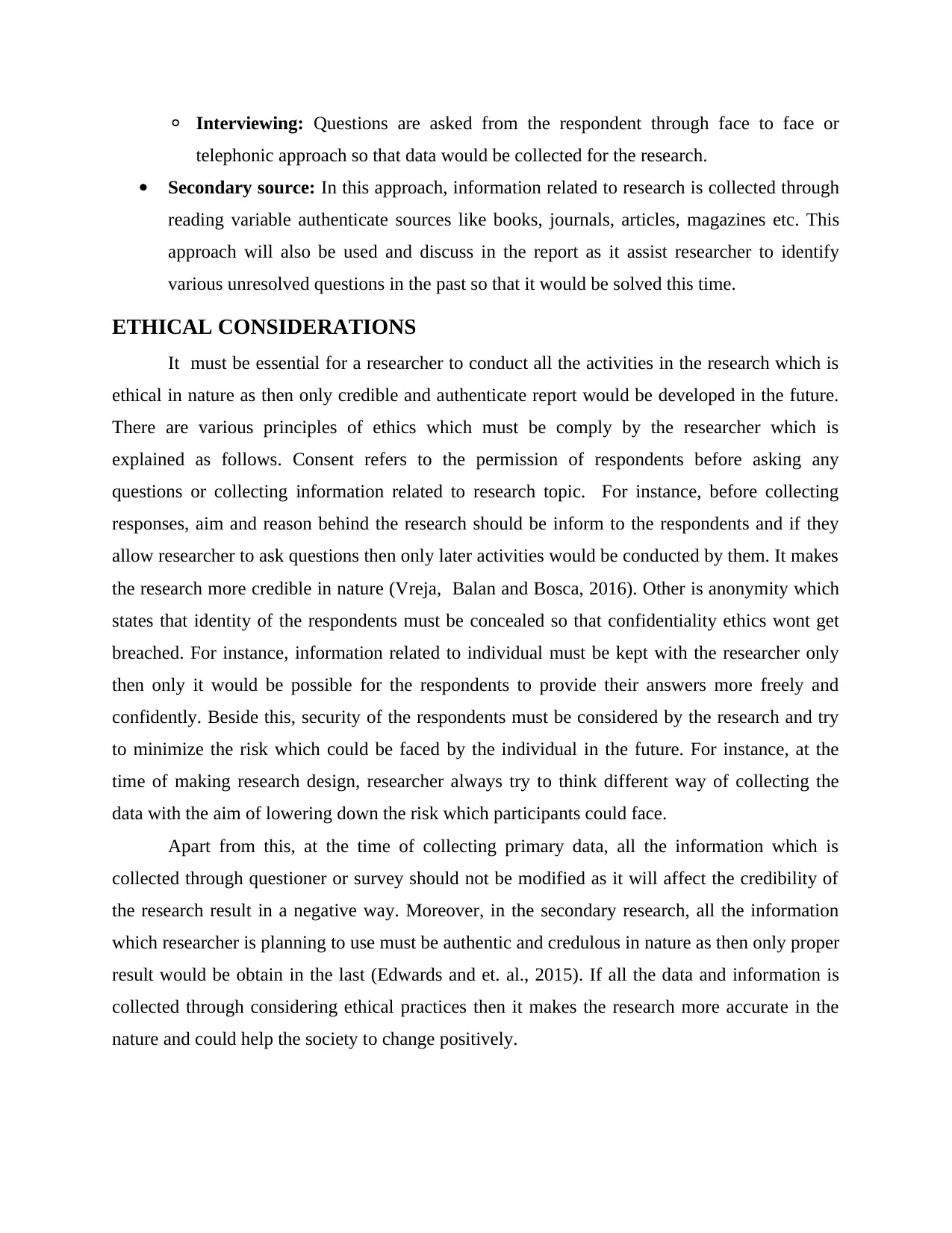
◦ Interviewing: Questions are asked from the respondent through face to face or
telephonic approach so that data would be collected for the research.
Secondary source: In this approach, information related to research is collected through
reading variable authenticate sources like books, journals, articles, magazines etc. This
approach will also be used and discuss in the report as it assist researcher to identify
various unresolved questions in the past so that it would be solved this time.
ETHICAL CONSIDERATIONS
It must be essential for a researcher to conduct all the activities in the research which is
ethical in nature as then only credible and authenticate report would be developed in the future.
There are various principles of ethics which must be comply by the researcher which is
explained as follows. Consent refers to the permission of respondents before asking any
questions or collecting information related to research topic. For instance, before collecting
responses, aim and reason behind the research should be inform to the respondents and if they
allow researcher to ask questions then only later activities would be conducted by them. It makes
the research more credible in nature (Vreja, Balan and Bosca, 2016). Other is anonymity which
states that identity of the respondents must be concealed so that confidentiality ethics wont get
breached. For instance, information related to individual must be kept with the researcher only
then only it would be possible for the respondents to provide their answers more freely and
confidently. Beside this, security of the respondents must be considered by the research and try
to minimize the risk which could be faced by the individual in the future. For instance, at the
time of making research design, researcher always try to think different way of collecting the
data with the aim of lowering down the risk which participants could face.
Apart from this, at the time of collecting primary data, all the information which is
collected through questioner or survey should not be modified as it will affect the credibility of
the research result in a negative way. Moreover, in the secondary research, all the information
which researcher is planning to use must be authentic and credulous in nature as then only proper
result would be obtain in the last (Edwards and et. al., 2015). If all the data and information is
collected through considering ethical practices then it makes the research more accurate in the
nature and could help the society to change positively.
telephonic approach so that data would be collected for the research.
Secondary source: In this approach, information related to research is collected through
reading variable authenticate sources like books, journals, articles, magazines etc. This
approach will also be used and discuss in the report as it assist researcher to identify
various unresolved questions in the past so that it would be solved this time.
ETHICAL CONSIDERATIONS
It must be essential for a researcher to conduct all the activities in the research which is
ethical in nature as then only credible and authenticate report would be developed in the future.
There are various principles of ethics which must be comply by the researcher which is
explained as follows. Consent refers to the permission of respondents before asking any
questions or collecting information related to research topic. For instance, before collecting
responses, aim and reason behind the research should be inform to the respondents and if they
allow researcher to ask questions then only later activities would be conducted by them. It makes
the research more credible in nature (Vreja, Balan and Bosca, 2016). Other is anonymity which
states that identity of the respondents must be concealed so that confidentiality ethics wont get
breached. For instance, information related to individual must be kept with the researcher only
then only it would be possible for the respondents to provide their answers more freely and
confidently. Beside this, security of the respondents must be considered by the research and try
to minimize the risk which could be faced by the individual in the future. For instance, at the
time of making research design, researcher always try to think different way of collecting the
data with the aim of lowering down the risk which participants could face.
Apart from this, at the time of collecting primary data, all the information which is
collected through questioner or survey should not be modified as it will affect the credibility of
the research result in a negative way. Moreover, in the secondary research, all the information
which researcher is planning to use must be authentic and credulous in nature as then only proper
result would be obtain in the last (Edwards and et. al., 2015). If all the data and information is
collected through considering ethical practices then it makes the research more accurate in the
nature and could help the society to change positively.
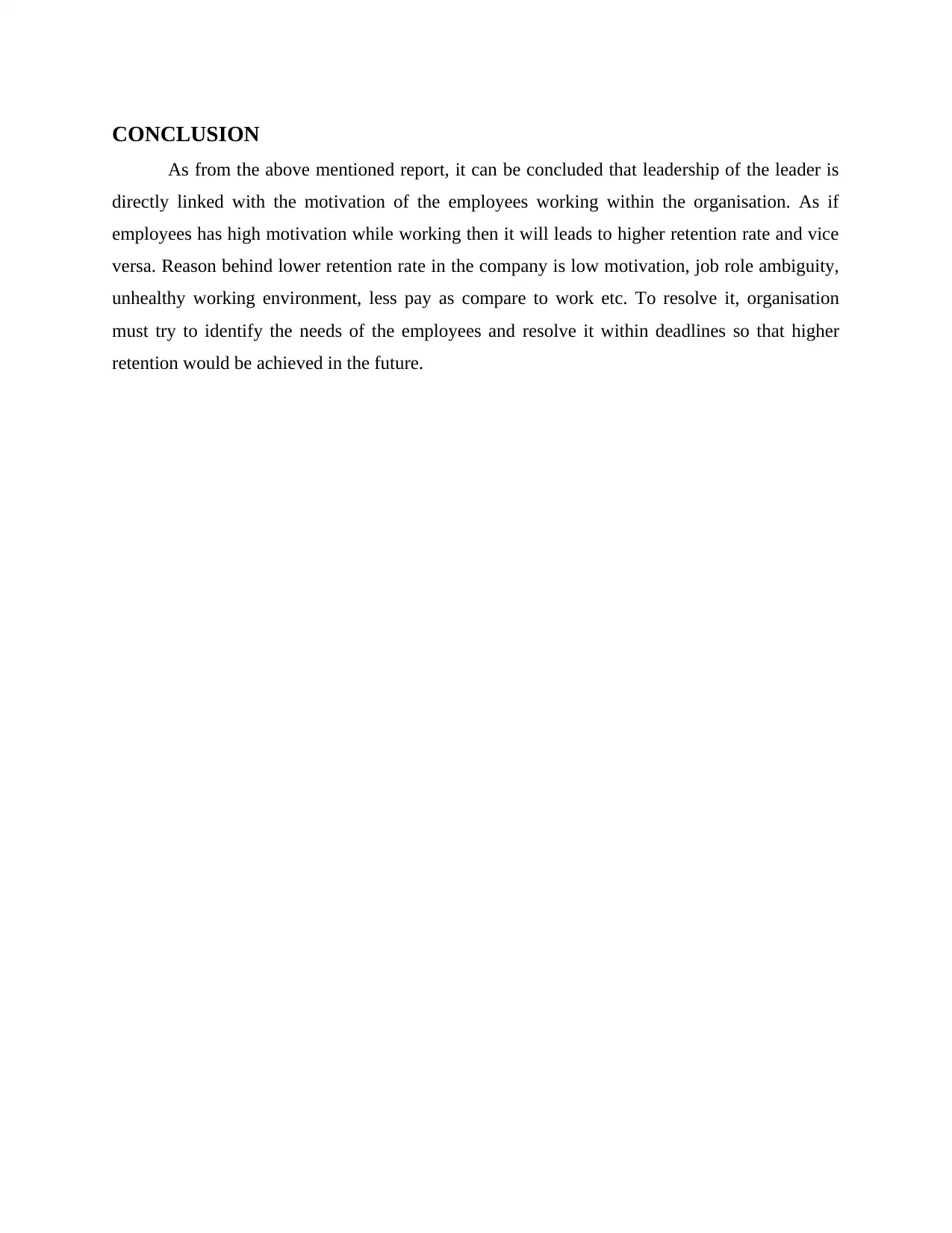
CONCLUSION
As from the above mentioned report, it can be concluded that leadership of the leader is
directly linked with the motivation of the employees working within the organisation. As if
employees has high motivation while working then it will leads to higher retention rate and vice
versa. Reason behind lower retention rate in the company is low motivation, job role ambiguity,
unhealthy working environment, less pay as compare to work etc. To resolve it, organisation
must try to identify the needs of the employees and resolve it within deadlines so that higher
retention would be achieved in the future.
As from the above mentioned report, it can be concluded that leadership of the leader is
directly linked with the motivation of the employees working within the organisation. As if
employees has high motivation while working then it will leads to higher retention rate and vice
versa. Reason behind lower retention rate in the company is low motivation, job role ambiguity,
unhealthy working environment, less pay as compare to work etc. To resolve it, organisation
must try to identify the needs of the employees and resolve it within deadlines so that higher
retention would be achieved in the future.
⊘ This is a preview!⊘
Do you want full access?
Subscribe today to unlock all pages.

Trusted by 1+ million students worldwide
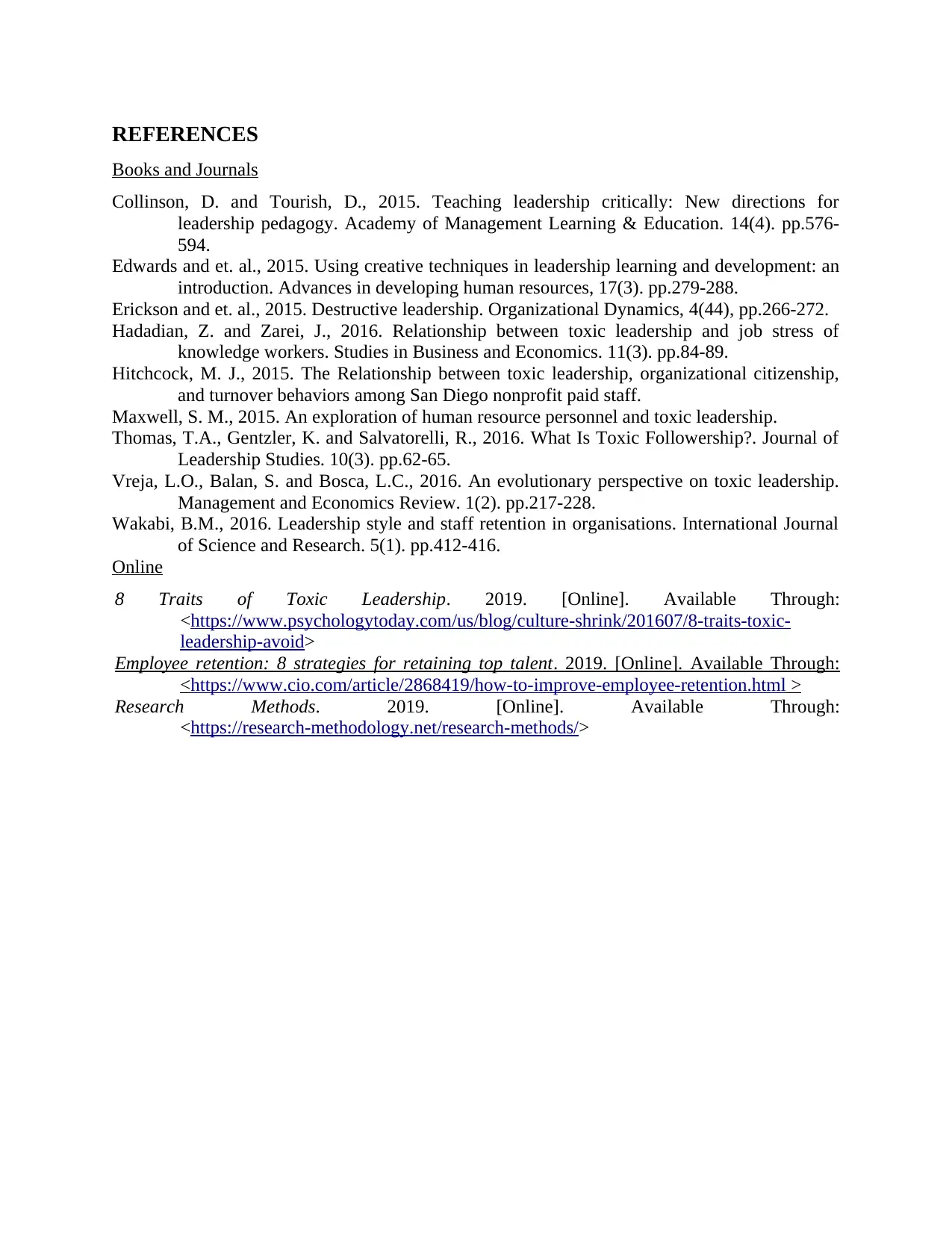
REFERENCES
Books and Journals
Collinson, D. and Tourish, D., 2015. Teaching leadership critically: New directions for
leadership pedagogy. Academy of Management Learning & Education. 14(4). pp.576-
594.
Edwards and et. al., 2015. Using creative techniques in leadership learning and development: an
introduction. Advances in developing human resources, 17(3). pp.279-288.
Erickson and et. al., 2015. Destructive leadership. Organizational Dynamics, 4(44), pp.266-272.
Hadadian, Z. and Zarei, J., 2016. Relationship between toxic leadership and job stress of
knowledge workers. Studies in Business and Economics. 11(3). pp.84-89.
Hitchcock, M. J., 2015. The Relationship between toxic leadership, organizational citizenship,
and turnover behaviors among San Diego nonprofit paid staff.
Maxwell, S. M., 2015. An exploration of human resource personnel and toxic leadership.
Thomas, T.A., Gentzler, K. and Salvatorelli, R., 2016. What Is Toxic Followership?. Journal of
Leadership Studies. 10(3). pp.62-65.
Vreja, L.O., Balan, S. and Bosca, L.C., 2016. An evolutionary perspective on toxic leadership.
Management and Economics Review. 1(2). pp.217-228.
Wakabi, B.M., 2016. Leadership style and staff retention in organisations. International Journal
of Science and Research. 5(1). pp.412-416.
Online
8 Traits of Toxic Leadership. 2019. [Online]. Available Through:
<https://www.psychologytoday.com/us/blog/culture-shrink/201607/8-traits-toxic-
leadership-avoid>
Employee retention: 8 strategies for retaining top talent. 2019. [Online]. Available Through:
<https://www.cio.com/article/2868419/how-to-improve-employee-retention.html >
Research Methods. 2019. [Online]. Available Through:
<https://research-methodology.net/research-methods/>
Books and Journals
Collinson, D. and Tourish, D., 2015. Teaching leadership critically: New directions for
leadership pedagogy. Academy of Management Learning & Education. 14(4). pp.576-
594.
Edwards and et. al., 2015. Using creative techniques in leadership learning and development: an
introduction. Advances in developing human resources, 17(3). pp.279-288.
Erickson and et. al., 2015. Destructive leadership. Organizational Dynamics, 4(44), pp.266-272.
Hadadian, Z. and Zarei, J., 2016. Relationship between toxic leadership and job stress of
knowledge workers. Studies in Business and Economics. 11(3). pp.84-89.
Hitchcock, M. J., 2015. The Relationship between toxic leadership, organizational citizenship,
and turnover behaviors among San Diego nonprofit paid staff.
Maxwell, S. M., 2015. An exploration of human resource personnel and toxic leadership.
Thomas, T.A., Gentzler, K. and Salvatorelli, R., 2016. What Is Toxic Followership?. Journal of
Leadership Studies. 10(3). pp.62-65.
Vreja, L.O., Balan, S. and Bosca, L.C., 2016. An evolutionary perspective on toxic leadership.
Management and Economics Review. 1(2). pp.217-228.
Wakabi, B.M., 2016. Leadership style and staff retention in organisations. International Journal
of Science and Research. 5(1). pp.412-416.
Online
8 Traits of Toxic Leadership. 2019. [Online]. Available Through:
<https://www.psychologytoday.com/us/blog/culture-shrink/201607/8-traits-toxic-
leadership-avoid>
Employee retention: 8 strategies for retaining top talent. 2019. [Online]. Available Through:
<https://www.cio.com/article/2868419/how-to-improve-employee-retention.html >
Research Methods. 2019. [Online]. Available Through:
<https://research-methodology.net/research-methods/>
1 out of 10
Related Documents
Your All-in-One AI-Powered Toolkit for Academic Success.
+13062052269
info@desklib.com
Available 24*7 on WhatsApp / Email
![[object Object]](/_next/static/media/star-bottom.7253800d.svg)
Unlock your academic potential
Copyright © 2020–2025 A2Z Services. All Rights Reserved. Developed and managed by ZUCOL.




